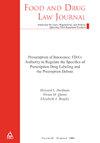在FDA药品监管中实施公共卫生观点
IF 0.3
4区 医学
Q4 FOOD SCIENCE & TECHNOLOGY
引用次数: 8
摘要
毫无疑问,美国的公共卫生危机是由非法和处方阿片类药物滥用、成瘾和过量引起的。美国食品和药物管理局(FDA)是一个监管机构,在最大限度地减少处方阿片类药物的危害方面发挥着重要作用,同时也确保处方阿片类药物可用于基于证据的疼痛管理。然而,有一个问题是,该机构在决定批准阿片类药物并使现有的阿片类药物继续在市场上销售时,在多大程度上可以考虑到导致这种流行病的提供者和患者行为。在某种程度上,这是因为FDA对药物的批准通常被理解为狭隘地关注于权衡产品的收益和风险,这些产品是在预先批准的临床试验中定义的,用于确定药物的官方FDA批准适应症。这种有限的关注将排除有关处方类阿片和其他具有外部性的药物的实际使用和公共卫生影响的重要信息。本文认为,为了更好地监管像阿片类药物这样具有外部性的药物,FDA应该采取的一个步骤是在批准(和撤回)决定时使用“公共卫生”的观点。本文描述了联邦食品、药品和化妆品法案如何授权FDA在其药物批准和撤回决定中采用这种广泛的方法,并提供了系统地实施这种方法的一些原则。引用本文:Patricia J. Zettler, Margaret Foster Riley, Aaron S. Kesselheim, FDA药品监管中公共卫生视角的实施,73 Food & Drug L.J. 221(2018)。经食品药品法律研究所许可发布。本文章由计算机程序翻译,如有差异,请以英文原文为准。
Implementing a Public Health Perspective in FDA Drug Regulation
There is, without question, a public health crisis in the United States arising from both illicit and prescription opioid misuse, addiction, and overdose. The Food and Drug Administration (FDA) is one regulator with an important role to play in minimizing the harms associated with prescription opioids, while also ensuring that prescription opioids are available for the evidence-based management of pain. One question, however, is to what extent the agency can consider in its decisions to approve opioids and keep existing ones on the market the provider and patient behaviors contributing to the epidemic. This is, in part, because FDA’s approval of drugs is often understood as narrowly focused on weighing the benefits and risks of the products as defined in the preapproval clinical trials that are used to set the drug’s official FDA-approved indication. Such a limited focus would exclude important information about the real-world use and public-health impact of prescription opioids and other drugs with externalities. This Article argues that, to better regulate drugs like opioids that have such externalities, one step FDA should take is to use a “public health” perspective in its approval (and withdrawal) decisions. The Article describes how the federal Food, Drug, and Cosmetic Act authorizes FDA to take this broad approach in its drug approval and withdrawal decisions and offers some principles for implementing this approach systematically.Citation: Patricia J. Zettler, Margaret Foster Riley, and Aaron S. Kesselheim, Implementing a Public Health Perspective in FDA Drug Regulation, 73 Food & Drug L.J. 221 (2018).Posted with the permission of the Food and Drug Law Institute.
求助全文
通过发布文献求助,成功后即可免费获取论文全文。
去求助
来源期刊

Food and drug law journal
医学-食品科技
CiteScore
0.20
自引率
50.00%
发文量
0
审稿时长
>36 weeks
期刊介绍:
The Food and Drug Law Journal is a peer-reviewed quarterly devoted to the analysis of legislation, regulations, court decisions, and public policies affecting industries regulated by the U.S. Food and Drug Administration (FDA) and related agencies and authorities, including the development, manufacture, marketing, and use of drugs, medical devices, biologics, food, dietary supplements, cosmetics, veterinary, tobacco, and cannabis-derived products.
Building on more than 70 years of scholarly discourse, since 2015, the Journal is published in partnership with the Georgetown University Law Center and the O’Neill Institute for National & Global Health Law.
All members can access the Journal online. Each member organization and most individual memberships (except for government, student, and Emeritus members) receive one subscription to the print Journal.
 求助内容:
求助内容: 应助结果提醒方式:
应助结果提醒方式:


